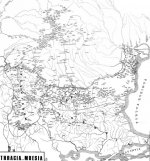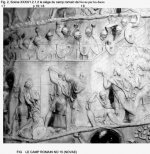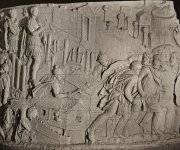Diurpaneus
Banned
- Messages
- 249
- Reaction score
- 21
- Points
- 0
- Location
- Bărăgan
- Ethnic group
- Thraco-Roman
- Y-DNA haplogroup
- Argeș(~SER+MAC)
- mtDNA haplogroup
- Walati(Vlachs)
I always wondered if there were some Italic tribes in Romania in pre-Roman and Roman times. Left over after Italics' migration from East to West? They came from somewhere East, settled in Valachia(?), then after few centuries, half of them moved to Italy, half stayed there. This might explain dominance of Romance/Vlach language in this area, In other areas it was easier for Thracians to change to old Slavic, because of similarities and satem nature of these two languages.
That's a good point ,but i wouldn't go that far, at least regarding the Romanian language.
It's likely that the Thracians absorbed some proto-Italic tribes who were left behind.
See Thracian"romphaia",cognate to Latin "rumpere"(to break).
From the archaeological point of view, Wallachia(Monteoru culture is the most proposed horizon for an "autohtonous"Thracian culture spreaded to Moldavia and parts of Transylvania also),historical Moldavia and some regions further east,from Ukraine, were the original Thracian lands.
Later from Monteoru with a Srubna imput, Sabatinovka-Noua-Coslogeni complex emerged.But the influences diffused also from the Danube to Ukraine(see Kuzmina-"The Origin of the Indo-Iranians" pg.355-360, on google books).
This is the so called "Cimmerian" or "Thraco-Cimmerain" horizon.
In most of the Transylvania and towards Hungarian border,material culture presents analogies with the Central European area (till eastern Alps).
Transylvanian cultures were pressured by the eastern tribes who were looking for gold and copper.
Although cultural traits from these tribes were preserved till later stages,in the 6-4 cent. BC the Agathyrsi( a Scythian group with analogies in the Middle Dnieper area and Podolia) occupied that area.
Getae-Dacian language(s) were surely of Satem type.The words, toponyms etc.preserved show similarities to Thracian-Baltic(although you could group some Dacian-Thracian words ,most of them were closer to Baltic) and Iranian.
For instance, Dacian "dava" is related to Zazaki "Dewe"(a village) and Persian "Divar"(a Wall).
Romanian and Aromanian are more "abrasive" than other Romanic languages ,because Latin was adopted by some Satem speakers.
We can exclude the Slavic influence,who is virtually absent in Aromanian.
Romanian is a Late Antiquity product(it is closer to all the Romance languages than Latin,especially to southern Italian dialects,because of the Eastern Roman Empire influence in Italy;however this not necesarly imply a migrationist scenario,the colonists that were left behind after the Aurelian Withdraw received influences-religious books ,bishops- from south of the Danube)
,developed in the Moesia Prima,Dacia Ripensis,Dacia Mediterranea Moesia Secunda as well as N Dardania and NW Thrace.
http://en.wikipedia.org/wiki/La_Spezia–Rimini_Line
"The long interval between the two civil-war triumphs of the Danube
legions, in 69 for the Flavians and in 193 for the Severi, witnessed a steady
but unremarkable assimilation of the Celtic, Illyrian and Thracian peoples
of the Danube lands to a Latin-speaking Roman provincial culture. On the
south a limit was set to this process by the Hellenistic traditions of the
ancient kingdoms of Epirus, Macedonia and Thrace
The Danube provinces of the Roman empire
were dominated by the presence of the army. By around the end of the
period almost half of the legions (twelve out of thirty; c. 60,000 men) and
more than a third of the auxilia (c. 80,000 men) were based along the Danube.
The legions which had advanced the boundaries of the empire to
the Danube in the first century A.D. came from Italy and the colonies.
By the middle decades of the second century there had developed in the
Danube provinces a Latin-speaking Roman provincial culture to which
local native traditions appear to have contributed little. This was based on
the growing settlements along the river and was bound up with the influence
of locally recruited legions and auxilia.
The Latin language was dominant throughout the frontier provinces of
the Danube. Greek remained confined to the southern Balkans and did
not spread significantly beyond the limits of Hellenistic Macedonia and
Thrace. As most recently defined from the evidence of inscriptions, the linguistic
frontier in Roman Europe followed more or less the southern boundaries
of Latin Dalmatia, Moesia Superior and Moesia Inferior; and this
demarcation altered hardly at all during the Roman era.
Little sign of what might be termed ‘native resistance’ to Roman rule and
the way of life in general can be seen in the Danube provinces. There were
undoubtedly recurrent outbreaks of brigandage, some serious, in several
areas. Yet there is no suggestion that any of it was a reaction specifically
to Roman rule, any more than it has been to the several comparable regimes
that have sought to dominate the Balkans since then. The native peoples
came to accept a version of the Roman way of life. From among the native
Danubians who joined first the auxilia and then the legions we can recognize
the ancestors of a military class who were to become dominant in the
empire from the middle of the third century."(Cambridge Ancient History vol.11).
The Latin inscriptions distribution:





